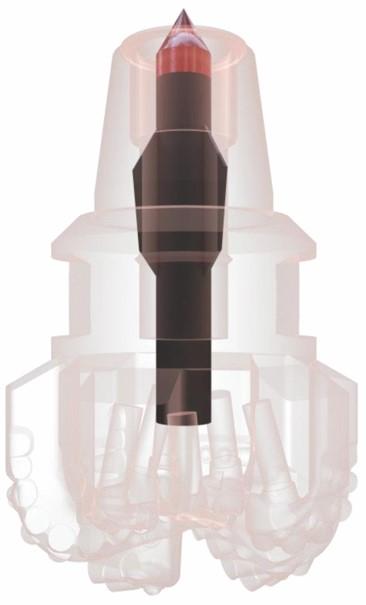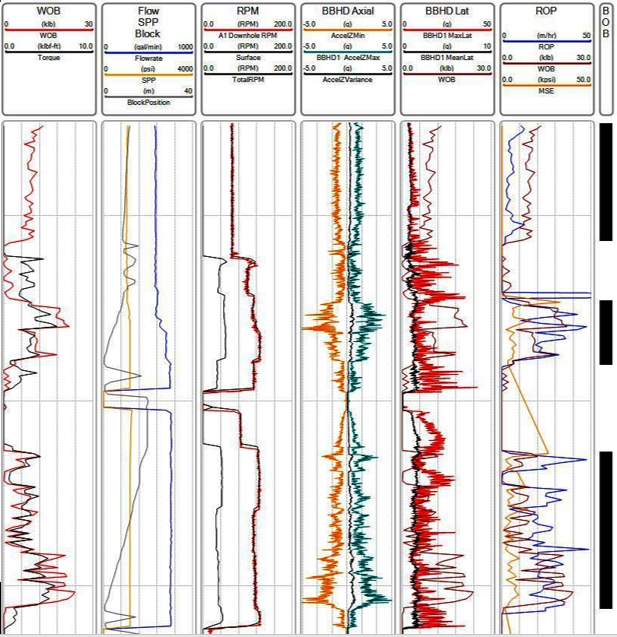The case has been made repeatedly over the past decade to better integrate data collection into drilling operations. While significant technology improvements throughout this time frame have yielded an abundance of tools designed to collect downhole data for post-run analysis, most of these tools do not capture data directly from the bit; rather, they are placed in a carrier sub or various positions in the bottomhole assembly (BHA).
For more than a decade, National Oilwell Varco (NOV) has been measuring high-frequency at-bit and in-the-bit dynamics to further optimize bit and BHA designs as well as to provide information on optimal running parameters. Continuous advances in downhole technology at NOV have resulted in the development and iterative improvement of a tool that can be placed in the drillbit to measure tangential acceleration and angular position, which results in axial, lateral and torsional vibration and RPM values. Knowing such parameters acquired directly at the bit allows operators to optimize their drilling programs for challenging applications where significant drilling dysfunctions require superior bit performance.
NOV’s BlackBox HD tool is a memory- mode logging tool designed to help operators address common downhole drilling dysfunctions, such as stick/ slip and whirl, by enabling better decision-making in future wells to improve overall drilling performance and reduce well delivery costs. The tool has no nonmagnetic requirements and a self-contained power supply, meaning it does not interfere with other electronics in the drillstring (Figure 1).
The tool records for up to 150 hours of battery life and captures high-frequency burst data at 800 Hz. These data are the core component of a drilling optimization service provided by NOV, with subject matter experts both on the rig and in NOV engineering technology centers analyzing the data and highlighting areas where parameters or designs can be changed to improve drilling performance and overcome dysfunctions.
Case histories
An operator in Kenya was drilling a challenging section through hard volcanic basalts. NOV’s FluidHammer performance drilling tool offered a new method to fail the rock while maintaining high ROP through the volcanic basalts. The operator needed to achieve higher ROP without creating excessive damaging vibration, which would prematurely damage the PDC drillbit. The primary objective was to consistently drill the section through the volcanic basalts in one run, including drilling through the cement using the FluidHammer toolset with a bend to allow effective sliding and building to the tangent. The operator needed to validate that the section could be drilled with a PDC bit, as it had previously only used roller-cone bits, and that the FluidHammer tool would not cause excessive harmful vibration.
Data from the BlackBox HD tool at the bit revealed that the FluidHammer tool maintained axial oscillation within safe levels to maintain the PDC bit’s cutter integrity, and lateral vibration decreased with the FluidHammer tool engaged and BHA oscillating axially. On this run the operator achieved on-bottom ROP of 18 m/hr (59 ft/hr) and a high ROP of 16.6 m/hr (54.4 ft/hr) through the volcanic basalts with the tool effectively engaging the volcanic section with no stick/slip. The bit dull came in with a positive result, and the higher ROP eliminated almost two days of drilling time.
In a different application, an offshore Congo operator was drilling long horizontals in its 8?-in. section and suffering from extreme vibration and poor directional control to the point of risking reductions in production potential. After running the BlackBox HD tool and conducting the associated optimization analysis service, NOV determined the root cause of the dysfunction and identified the service company’s tools were experiencing full stick/slip.
During the slip phase, the dysfunction translated to apparent lateral vibration as measured by the slower speed data recorded on the service company’s accelerometers. This occurred because the offset-from-center accelerometers were confusing radial acceleration (due to high and violent angular acceleration during the slip phase) with lateral vibration, causing the operator to reduce RPM and increase weight on bit (WOB). Though this was intended to eliminate the lateral vibration, the misconception exacerbated stick/slip farther, as the operator would have done the opposite—increase RPM and decrease WOB—if it had had the correct data. Once the operator ran the BlackBox HD, the data quantified the severity of the stick/slip and lack of lateral vibration. The data proved it was impossible for the rotary steerable system (RSS) to maintain toolface control during events with such high torsional vibration.
After running NOV’s enhanced measurement system tool, which adds high-speed downhole WOB and torque-on-bit measurements, the operator discovered that the torque generated downhole from the bit/BHA was negligible; rather, most of the torque and drag came from the heavyweight drillpipe, which was causing the stick/slip. Raising RPM only increased the severity of the stick/slip, and decreasing WOB had little to no effect due to the lack of drilling torque, as most of the torque was coming from drag along the string. Realistically, small pipe in this extended horizontal application will almost always encounter such a problem, but due to equivalent circulating density limitations, running larger pipe was not an option.
Several options were explored to resolve the issue. However, after understanding the tool, parameter and equipment constraints, NOV determined that stick/slip could not be eliminated and it must simply be reduced to acceptable levels. The final solution was to maintain RPM below a certain range so that RPM would not exceed the RSS toolface control limit during the slip phase. This was accomplished even though RPM in the slip phase was exceeding top drive RPM speed by almost 200%. By remaining within the tools operating limitations even during the slip phase, the operator and service company were able to achieve their directional targets successfully. Understanding the root cause of the problem using high-frequency measurements inside the drillbit and along-string measurements allowed the best solution to be implemented.
Conclusion
The need for better forms of data collection and analysis has grown due to the challenges of unconventional wells. As continued oil pricing pressures necessitate greater efficiencies, drilling optimization will remain an important method of cost-effectively achieving business goals and operational success. Being able to collect high-quality downhole data and drilling dynamics information at the bit is one step toward proper drilling optimization, and the BlackBox HD tool has been making this a reality for a decade.

 石油圈
石油圈


